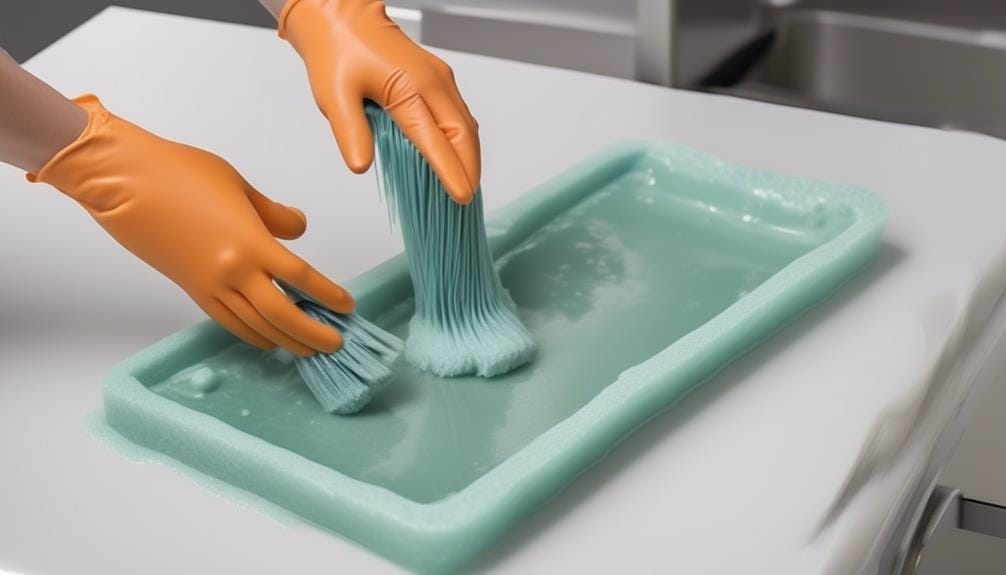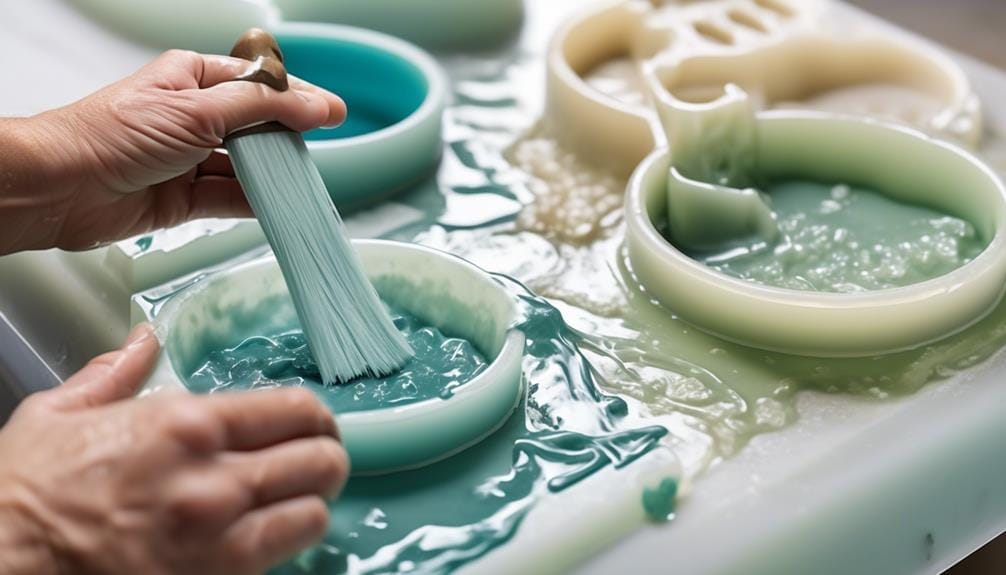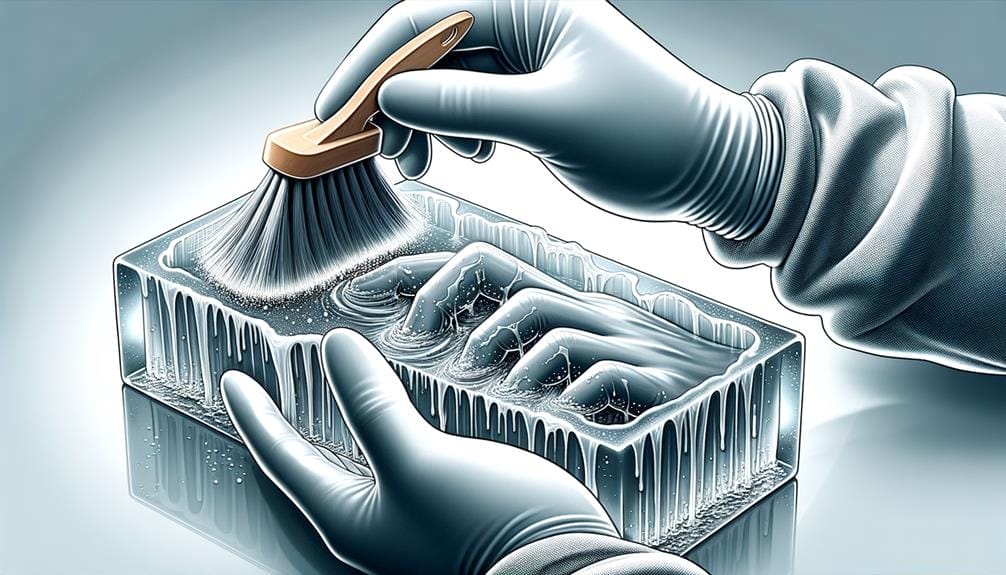Table of Contents
Add a header to begin generating the table of contents
Cleaning epoxy resin molds can be a bit of a challenge, but with the right techniques, you can easily ensure their cleanliness and longevity. Whether you’re a seasoned resin artist or a beginner, maintaining the cleanliness of your molds is essential for producing high-quality resin pieces.
You may have encountered some stubborn residue or debris that seems impossible to remove, but fear not! In this discussion, we will reveal some effective methods and expert tips that will leave your epoxy resin molds looking as good as new.
So, if you’re ready to discover the secrets of achieving spotless and flawless molds, let’s dive right in.
 Consider utilizing the freezing method to remove stubborn residue from epoxy resin molds. This method involves embrittling the residue by freezing it and then gently scraping it away from the molds. Here is how you can use the freezing method to clean your resin molds effectively:
Consider utilizing the freezing method to remove stubborn residue from epoxy resin molds. This method involves embrittling the residue by freezing it and then gently scraping it away from the molds. Here is how you can use the freezing method to clean your resin molds effectively:
 For expert tips on cleaning your epoxy resin molds, try using tape to remove loose debris, grime, and dust. This method is quick and effective in getting rid of surface contaminants before moving on to deeper cleaning.
Here are some additional tips to make sure your molds stay clean and in good condition:
For expert tips on cleaning your epoxy resin molds, try using tape to remove loose debris, grime, and dust. This method is quick and effective in getting rid of surface contaminants before moving on to deeper cleaning.
Here are some additional tips to make sure your molds stay clean and in good condition:
Key Takeaways
- Mix a gentle cleaning solution and scrub the mold surface with a sponge or brush to remove dirt and debris.
- Use warm, soapy water to wash the mold and let it soak for stubborn residue.
- Consider using the freezing method by placing the molds in a freezer to make residue brittle and then scrape it off.
- Regularly clean the molds with mild dish soap and warm water, and store them in a cool, dry place away from direct sunlight and high heat.
Preliminary Cleaning Methods
To begin cleaning your epoxy resin molds, you can optionally start by using a gentle cleaning solution. This will help remove any residue or dirt that may have accumulated on the surface of the mold. To clean the mold, mix the cleaning solution with water according to the instructions on the product. Then, dip a sponge or soft brush into the solution and gently scrub the surface of the mold. Be sure to cover all areas of the mold, including any crevices or corners. Once you have thoroughly cleaned the mold, rinse it with clean water to remove any remaining cleaning solution. To dry the mold, you can either air dry it or use a soft cloth or towel to gently pat it dry. It’s important to ensure that the mold is completely dry before using it again to avoid any moisture affecting the resin.Primary Cleaning
Start by removing any loose debris from your resin mold using tape or sticky tacky putty. This will help ensure that your mold is clean and ready for the next step. After removing the debris, it’s time to give your mold a good cleaning. One effective method is to wash the mold in warm, soapy water. This will help remove any dirt, dust, or residue that may be stuck to the mold. You can use a soft sponge or brush to gently scrub the surface of the mold. If you’re dealing with stubborn residue or dried resin, you can let the mold soak in the soapy water for a few minutes to loosen it up. After cleaning, rinse the mold with hot water to remove any soap residue. Finally, let the mold air dry before using it again. To summarize the primary cleaning process for resin molds:| Steps | Cleaning Method |
|---|---|
| 1 | Remove loose debris with tape or sticky tacky putty |
| 2 | Wash in warm, soapy water |
| 3 | Gently scrub with a soft sponge or brush |
| 4 | Let soak for stubborn residue |
| 5 | Rinse with hot water |
| 6 | Air dry |
Secondary Cleaning Method

- Place the resin molds in a freezer for several hours until the residue becomes brittle.
- Remove the molds from the freezer and use a soft cloth or a plastic scraper to gently scrape away the residue. Be careful not to damage the molds during this process.
Additional Cleaning Notes
If residue problems persist even after trying the freezing method, it may be necessary to consider replacing the epoxy resin molds. Sometimes, no matter how hard you try to clean the molds, stubborn resin residues just won’t budge. In such cases, it’s best to invest in new molds to ensure the quality of your resin projects. To keep your molds clean and prevent dust or other particles from sticking to the resin, make sure to regularly clean the molds after each use. Use mild dish soap and warm water to gently wash the molds. Avoid using hot water as it can make the molds dull over time. When cleaning your mold, be cautious not to use any abrasive materials that may scratch the surface. Tiny holes in silicone molds can disrupt the nonstick surface, so it’s important to handle them with care. To ease resin removal and prolong the lifespan of your mold, consider using a mold release spray. This spray creates a thin layer between the resin and the mold, making it easier to remove the cured resin without damaging the mold.Expert Tips for Mold Cleaning

- Soak your molds in a solution of hot water and dish detergent. Gently rub the surface of the molds to remove any residue or stubborn stains. This method is especially useful for removing sticky substances or dried-on resin.
- Consider placing your mold in the freezer for a while. This can help embrittle the bond between the silicone and any residues, making them easier to clean off. Just be sure to remove the mold from the freezer and let it come back to room temperature before cleaning.
- After cleaning, make sure to dry your molds thoroughly. Use a soft cloth to remove any excess moisture. This helps prevent the growth of mold or mildew and keeps your molds in good condition.





